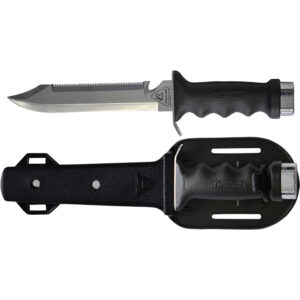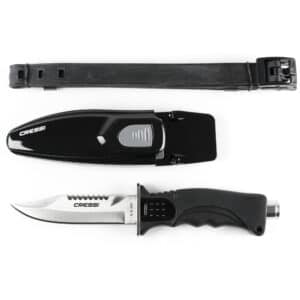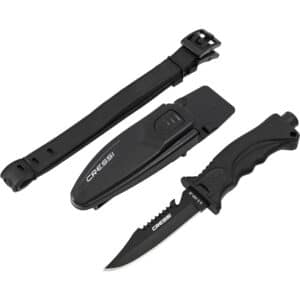Dive Knives for Saltwater
NOTE: Prices here are ONLINE ONLY. In-Store pricing may differ.
How to Choose the Right Dive Knife for Saltwater
Choose a saltwater dive knife that resists corrosion, cuts cleanly, and mounts where you can reach it with either hand. Start by picking a blade material. Titanium is great for maximum corrosion resistance. Consider marine-grade stainless with coatings for edge bite. Then decide on tip style (blunt for prying/safety around inflatables; point for precise cutting) and edge configuration. Straight, serrations and line cutter covers most tasks. Secure retention and an easy, one-hand draw matter more than size. The short list below highlights proven saltwater options:
- Cressi Grip Titanium
- Cressi Orca Knife
- Cressi Skorpion Knife – Point Tip (grey)
- Cressi Skorpion Knife (black/black)
Buyer’s Guide
- Materials & corrosion: Titanium resists rust best and is low-maintenance. Quality stainless offers aggressive bite but needs more rinse and dry. Rinse after every salt dive and lightly lube pivots/locks and sheath buttons.
- Tip & edges: Choose blunt tips for prying and boat safety. Pointed for precise cutting. A combo edge including straight, serrations and line cutting covers webbing, rope, and mono.
- Mounting & access: Confirm the sheath’s one-hand release and solid “click-in.” Mount on BCD webbing, hose, or calf/forearm.
- Size & control: Smaller profiles (ex: Grip Titanium) tuck in tight for reef work. Larger classics like Orca suit gloves and heavy duty use. Prioritize grip texture and hand-stop.
- Maintenance kit: Pack fresh-water rinse, silicone grease, and occasional sheath/strap spares. A quick rinse and dry post-dive drastically extends knife life in saltwater.
Saltwater Dive Knife Comparison
| Product | Key details | Best for | Notes |
|---|---|---|---|
| Cressi Grip Titanium | Compact titanium blade. Corrosion-proof with serrations/line cutter. | Minimalist salt dives. Tight mounting on BCD/hose | Low-maintenance; small footprint |
| Cressi Orca Knife | Large classic dive knife with robust handle and heavy-duty sheath. | Gloved hands. Prying and general utility | Bigger profile. Check mount position |
| Cressi Skorpion – Point Tip (grey) | Stainless blade with straight/serrated edge and line cutter. Quick-release sheath. | Precise cutting with option to pierce | Salt-ready—rinse/lube after dives. |
| Cressi Skorpion (black/black) | Compact handle, serrations and line cutter, secure sheath retention. | Everyday saltwater utility | Versatile option |
Frequently Asked Questions
Titanium vs stainless for salt water – which knife lasts longer?
Titanium resists corrosion best and needs the least upkeep. Stainless can feel sharper initially and is easier to hone in the field, but requires diligent rinse/dry and occasional lube. If you tend to skip maintenance, go titanium.
Is a blunt tip or point tip knife better for boat/reef work?
Choose a blunt tip for prying and safety around inflatables/rafts. Pick a point tip (ex: Skorpion point tip) for precise cutting when you need to pierce rope or mono.
Where should I mount my saltwater dive knife?
Mount where you can draw with either hand: BCD shoulder/waist webbing or inflator hose keep it visible; calf/forearm mounts work if you practice draws. Test sheath “click-in” and practice re-sheathing with gloves.
How do I keep a stainless dive knife from rusting?
Rinse thoroughly in fresh water after each dive, dry fully, and add a light film of silicone to the blade (avoid O-rings). Open/close the sheath mechanism to flush salt. Store dry and un-sheathed at home.
Small knife or large “classic” knife for saltwater?
Small knives (ex: Grip Titanium) are low-snag and easy to place; large knives (ex: Orca) are great with gloves and for leverage. Pick based on mounting location and how much prying you really do.




